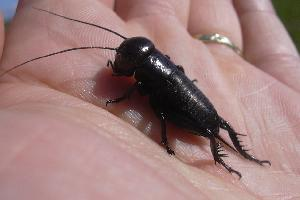
Poids et mesures
| Longueur | de 18 à 27 mm |
|---|
Description de l'animal
The European field cricket (Gryllus campestris) is a fascinating insect belonging to the Gryllidae family, which is well-known for its distinctive chirping sound. This species is native to Europe and has adapted to a variety of habitats across the continent, although it prefers warm and dry environments. The European field cricket is an integral part of the ecosystem, serving as both predator and prey within its natural habitat.Physical Description:
The European field cricket is a medium-sized cricket, with adult males typically measuring between 16 to 21 millimeters in length, while females are slightly larger, ranging from 17 to 22 millimeters. They possess a robust and compact body structure, characterized by their shiny black exoskeleton which provides excellent camouflage in their natural surroundings. Their head houses a pair of long, thread-like antennae, which are crucial for sensing their environment. One of the most distinctive features of the European field cricket is its large hind legs, which are not only adapted for jumping but also play a crucial role in the production of their iconic chirping sounds.
Behavior and Ecology:
The European field cricket is a ground-dwelling insect that exhibits remarkable burrowing behavior. They construct intricate tunnel systems in the soil, which serve as their homes, hiding spots from predators, and breeding grounds. These crickets are primarily nocturnal, venturing out of their burrows at night to feed on a variety of plant materials and smaller insects.
One of the most notable behaviors of the European field cricket is the male's chirping or stridulation, which is produced by rubbing their wings together. This sound serves multiple purposes; it is used to attract females for mating and to ward off rival males. The frequency and intensity of the chirping can vary, providing an auditory display of the male's fitness and territorial claims.
Reproduction:
The mating season for European field crickets typically begins in late spring and can continue into early summer. Following a successful mating, the female lays her eggs in the soil, utilizing a specialized ovipositor to insert them into the ground. These eggs overwinter and hatch into nymphs the following spring. The nymphs undergo several molts as they grow, eventually reaching adulthood and starting the cycle anew.
Conservation Status:
In recent years, the European field cricket has faced significant challenges, including habitat loss, agricultural practices, and climate change, leading to a decline in their populations in some areas. Conservation efforts are underway in various parts of Europe to protect and restore their natural habitats, including the creation of nature reserves and the implementation of sustainable farming practices that are sympathetic to the needs of native wildlife.
In conclusion, the European field cricket (Gryllus campestris) is a remarkable insect with a rich ecological role. Its distinctive chirping is a familiar sound of the European countryside, making it an emblematic species of the region's natural heritage. Despite facing challenges, ongoing conservation efforts offer hope for the preservation of this fascinating creature for future generations to enjoy.
Animaux similaires
Nouvelles photos d'animaux
Top 10 des animaux
- Dolphin gull (Leucophaeus scoresbii)
- Diana monkey (Cercopithecus diana)
- Moustached guenon (Cercopithecus cephus)
- Galápagos tortoise (Geochelone nigra complex)
- Russian tortoise (Testudo horsfieldii)
- Stone loach (Barbatula barbatula)
- Japanese macaque (Macaca fuscata)
- Greek tortoise (Testudo graeca)
- Common flying dragon (Draco volans)
- Vendace (Coregonus albula)
